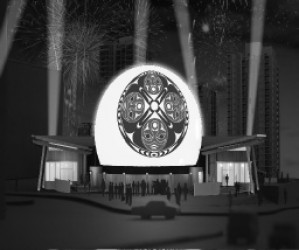Article Origin
Volume
Issue
Year
It is not a mirage but a Salish longhouse under construction on the plaza of the Queen Elizabeth Theatre in Vancouver’s downtown.
This 750-square metre Aboriginal pavilion in the centre of Olympic activity will be a gathering place for First Nation people to welcome the world to the 2010 Olympics and showcase the best of Aboriginal arts, crafts, sport and culture.
Planned by the Squamish, Lil’wat, Musqueam and Tsleil-Wautuuh of the Four Host First Nations, the $3 million pavilion reflects their history and culture.
Designed by Andrew Larigakis of Hotson Bakker Boniface and Haddon, the building is post and beam construction, with an interior lined with fir and cedar.
Built as a modern adaptation of a traditional longhouse, the building curves around a 278 square metre, high-tech stratosphere. By day, the giant translucent orb is white, but at night its translucent surface will reflect for passersby the videos being played inside its dome. Underneath the orb is a theatre space that will seat more than 200 people and located in the wings of the longhouse is a business centre, a meeting space, a green room, an elders’ lounge and a 457-square metre trading post.
The Queen Elizabeth restaurant and reception hall are attached to the compound for events. Catering will be the responsibility of the Four Host First Nations. Traditional foods will be served. On theme days, the food will reflect the part of Canada that they choose to showcase.
During the 17 days of the games, the trading post will highlight art created by emerging and established First Nation, Métis and Inuit artists from across Canada. It will include 1,200 commissioned hand-carved inukshuks from Nunavut. All crafts and art sold in the trading post will be authenticated by a Four Host First Nation logo designed by Judy Broomfield, a Squamish artist.
In addition, Coast Salish artist, Xwa lack tun has created authentic Aboriginal designs for canoes, paddles, pins and other souvenirs.
One third of the royalties from sales of the 2010 Aboriginal licensed art at the pavilion will go to the Aboriginal Youth Legacy Fund, which supports education, sport and cultural initiatives for Aboriginal youth in Canada and will continue far beyond the year 2010.
This licensing program is the first in an Olympic Games, in that an Olympic organizing committee has partnered with an Indigenous people to create an official licensed merchandising program that showcases excellence in Aboriginal arts, culture and enterprises.
Plans are in the works for the theatre space under the dome. Daily programs will include videos of First Nation activities, traditional performances, such as Inuit throat singing, Métis hoop dancing and jigging, as well as 21st century versions of Native performances. Currently, the Four Host First Nations is finalizing theme days so that each province and territory can host their own performance and event day in the pavilion.
After the games, the longhouse, which includes the trading post, but not the orb, will be relocated to a place, yet to be identified, as a permanent First Nation legacy of the games. The adjacent Queen Elizabeth restaurant will be converted into a reception hall featuring Aboriginal exhibits and cuisine.
The pavilion is right across the street from the Vancouver celebration site and within walking distance from GM Place and BC Place in the heart of the cultural district.
With its translucent orb shining out from the Queen Elizabeth plaza, the First Nation pavilion will not only be a gathering spot for First Nation people, but a gathering place for visitors from around the world.
- 3526 views

